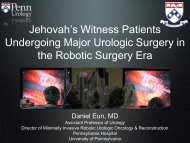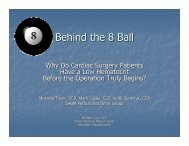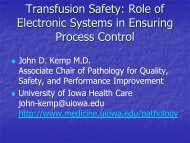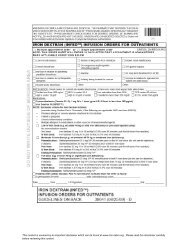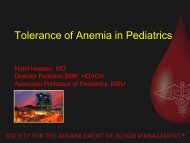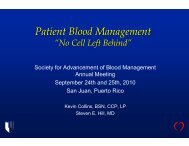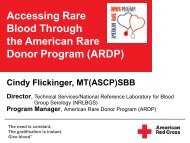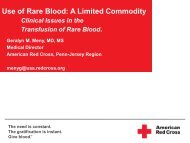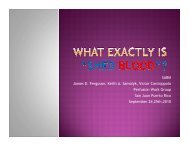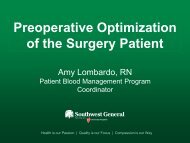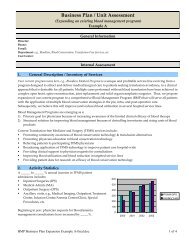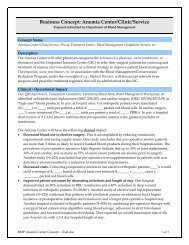Autologous Stem Cell Transplants in Jehovah's Witness: Series of ...
Autologous Stem Cell Transplants in Jehovah's Witness: Series of ...
Autologous Stem Cell Transplants in Jehovah's Witness: Series of ...
You also want an ePaper? Increase the reach of your titles
YUMPU automatically turns print PDFs into web optimized ePapers that Google loves.
<strong>Autologous</strong> <strong>Stem</strong> <strong>Cell</strong><strong>Transplants</strong> <strong>in</strong>Jehovah’s <strong>Witness</strong>:<strong>Series</strong> <strong>of</strong> 100 PatientsPatricia A. Ford, MDG<strong>in</strong>a Keck, RNNicole Brown, MDPennsylvania HospitalPhiladelphia, PA
Center for Bloodless Medic<strong>in</strong>e & Surgery‣ Established <strong>in</strong> 1998 atPennsylvania Hospital‣ 203 total transplants (As <strong>of</strong>09/15/11)‣ 102 JW‣ 18 Breast‣ 7 Ovarian‣ 1 Neuroblastoma‣ 45 Hodgk<strong>in</strong>’s Lymphoma‣ 44 NHL‣ 83 MM‣ 2 POEMS‣ 2 Amyloid‣ 1 APL8007006005004003002001000Patients Treated by CBMS726660633602604FY07 FY08 FY09 FY10 FY11
Challenges‣ Standard treatment for high-risk or relapsed lymphomaand multiple myeloma: HDC and ASCT‣ Most transplants require RBC and platelet support dueto anemia and pr<strong>of</strong>ound thrombocytopenia‣ Jehovah’s <strong>Witness</strong>es do not accept major blood productsfor religious reasons (Genesis 9:4, Leviticus 17:10, Acts15:29).‣ Report the result <strong>of</strong> a series <strong>of</strong> 100 JW who have beentreated with HDC and ASCT without use <strong>of</strong> blood productsvon Tresckow B, Engert A. Curr Hematol Malig Rep. 2011; 6(3): 172-9.Nademanee A et al. Biol Blood Marrow Transplant. 2011; 17(10): 1481-9.Wandt H et al. Bone Marrow Transplant. 2006; 37(4): 387-92.Kekre N et al. Transfusion. 2011; Ahead <strong>of</strong> pr<strong>in</strong>t.
Eligibility‣ All JW undergo<strong>in</strong>g HDC and ASCT at Pennsylvania Hospital05/1996-01/2011‣ Ejection fraction > 50%‣ Diffusion capacity <strong>of</strong> CO > 50%‣ CrCl > 60mL/m<strong>in</strong>‣ ECOG ≥ 2
Pre-Transplant and Tx•Use IV Fe & erythropoiet<strong>in</strong>to target Hgb = 11 g/dL•Peripheral blood stemcells mobilized us<strong>in</strong>g G-CSFand plerixafor to obta<strong>in</strong>m<strong>in</strong>imal collections <strong>of</strong> 4.0X 10 6 CD34+ cells/kgProcess•Peripheral blood stemcells processed <strong>in</strong> 5%album<strong>in</strong> <strong>in</strong> place <strong>of</strong> freshfrozen plasma•Transplant delayed untilpatient reaches m<strong>in</strong>imumprotocol requirements:•Hgb = 11g/dL•Platelets = 100,000/µLHDC•Patients receive standardHDC for primarymalignancyPrimeDelay
Post-Transplant SchemaBrown NM, Kim SY, and Ford PA. Bone MarrowTransplant. 2009; 44: 391-2.
Patient CharacteristicsTotal Patients (n) 100Age Mean 51 (21-70)Diagnosis (n)LymphomaMMBreastAmyloidosis514522CD34+ <strong>Cell</strong>s Re-<strong>in</strong>fusedPost HDC (10 6 )6.1 (1.0-24.6)
EngraftmentANC > 500µL for 3 days 9.6 days (5-18)Hgb (g/dL)OnsetDecrease <strong>in</strong> HgbNadirDays Hgb < 812.0 (7.0-15.3)5.3 (2.2-10.2)6.6 (2.0-11.6)7.8 (0-28)Platelet (10 3 /µL)OnsetDays Plt < 10NadirDays until Plt ≥ 20170 (65-502)3.9 (0-14)8.1 (1-50)10.5 (0-20)
Mortality‣ 6% mortality rate‣ Anemia (1%)‣ Presumed sepsis (1%)‣ Multi-organ failure due topancytopenia (1%)‣ Cardiac events (3%)‣ National mortality rate 1-3.5%for lymphoma and MM
Mortality‣ 6% mortality rate‣ Anemia (1%)‣ Presumed sepsis (1%)‣ Multi-organ failure due topancytopenia (1%)‣ Cardiac events (3%)‣ National mortality rate 1-3.5%for lymphoma and MMMorbidity‣ Bleed<strong>in</strong>g events‣ 13% Grade 1‣ Subconjuctival hemorrhage(5), epistaxis (5), m<strong>in</strong>orvag<strong>in</strong>al bleed<strong>in</strong>g (2),hematuria (1), m<strong>in</strong>or oralbleed<strong>in</strong>g (1), thigh hematoma(1)‣ 1% Grade 3 (GI)‣ 1% Grade 4 (temporal <strong>in</strong>farct)‣ All managed without transfusions‣ Cardiac complications‣ 26%‣ New onset arrhythmias (12),pr<strong>of</strong>ound HTN (10), CHF (10),acute MI (1)‣ No correlation betweencomplications and Hgb nadir
Cardiac Complications‣ Unexpected 26% cardiac complications‣ Cardiac toxicity could result from patients with pre-exist<strong>in</strong>g cardiac problemswhose conditions may have been be exacerbated by:‣ Cardiotoxic HDC regimen‣ cyclophosphamide, melphalan‣ Older age (p=0.005)‣ Pt develop<strong>in</strong>g cardiac complication: 54 ± 10 y/o‣ Pt who did not develop cardiac complication: 46 ± 13 y/o‣ Co-morbidities‣ Present <strong>in</strong> 58% <strong>of</strong> patients who developed cardiotoxicity‣ HTN, hyperlipidemia, CAD, DVT, sickle-cell anemia, alpha-thalassemia‣ Renal-impairment‣ Present <strong>in</strong> 35% <strong>of</strong> patients who developed cardiotoxicityBrockste<strong>in</strong> BE et al. Bone Marrow Transplant. 2000; 25: 885-894Gugl<strong>in</strong> M et al. Europace. 2009; 11: 1579-1586.Feliz V et al. Cl<strong>in</strong>ical Cardiology. 2011; 34(6): 359-9Mileshk<strong>in</strong> LR et al. Leukemia Lymphoma. 2005; 46(11): 1575-9
Conclusions‣ Us<strong>in</strong>g our blood management techniques, HDC with ASCT canbe safely performed without the use <strong>of</strong> blood products‣ Our reported 26% risk <strong>of</strong> cardiac complications were managedwith telemetry monitor<strong>in</strong>g, antiarrhymics and volumeresuscitation‣ More extensive cardiac screen<strong>in</strong>g warranted for select patientswho are older or have cardiovascular risks prior to HDC andASCT‣ Many <strong>of</strong> the blood management strategies utilized <strong>in</strong> bloodlessASCT may be appropriate <strong>in</strong> all patients undergo<strong>in</strong>g HDC andASCT and help m<strong>in</strong>imize risk for transfusion transmitteddiseases, immunosuppression, and immunologic reactions
JW; NHL, 3 months post-transplant



